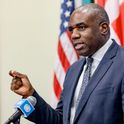The cream of America's black population has never done so well as in the last ten years—two secretaries of state, a national security adviser, chief of the armed forces, heads of major companies from American Express to Time Warner, congressmen and women, rectors of major universities, bishops, newspaper editorial writers. The list goes on and on, and perhaps later this year it will be capped by the election of a black president. What a difference from the 1960s, when only sport, the arts and preaching were open to ambitious blacks. Even in the 1970s, as I long ago documented in Encounter magazine, middle-class professional blacks were beginning to roar ahead in sizable numbers, closing the gap with their white peers. Thank you Martin Luther King.
But like America's infrastructure, neglect has meant that the cracks beneath are once again coming to the surface. Not, as in the past, in the form of civil rights agitation or riots, but in the shearing of family ties, educational failure and the appalling state of health and morbidity among American blacks. The "benign neglect" of Patrick Moynihan, social affairs adviser to President Nixon, has moved to malign neglect. Not that recent presidents have ignored the issue, but their various plans pale before the ambitions of Lyndon Johnson's far-sighted "war on poverty," which was sabotaged by the Vietnam war. Another such war is now needed.
The basic statistics have been thrown into relief by a new report, "The Measure of America," published by the American Human Development Report, which is modelled on the UN annual report of the same name. The UN report was the brainchild of the late Pakistani economist Mahbub ul Haq, and based on the work of the Indian Nobel economics laureate Amartya Sen.
Haq and Sen were convinced that the contemporary obsession with GNP growth was blinding both observers and participants to the tremendous advances that could be made in social wellbeing, even in quite poor countries, with only a modest rise in incomes. Haq produced the "Human Development Index" (HDI) in which countries were not ranked by income per head but by other yardsticks—longevity, knowledge and a decent standard of living. Today, Sweden and Norway come out top, with Denmark and Canada not far behind. The US is 12th. Some poor countries with low GNP outrank much more "developed" countries on the HDI.
With The Measure of America, the US is being measured not just in the round, as in the UN report, but in great detail. Northeastern states are way ahead, the south way behind. Looking at ethnicity, Asian-Americans are at the top of the index. They live an average eight years longer than whites and more than 13 years longer than African-Americans, the most disadvantaged group, whose average lifespan is shorter than the average American's 40 years ago.
Huge disparities in human development can be found in groups that live only a few miles from each other. Health standards for those living in the South Bronx today are equivalent to those living in Manhattan's East Side 50 years ago.
The results for Latinos are mixed. They have the lowest ranking of all in education. But they score well on health, coming third behind Asians and whites. But in a disturbing pattern, known as the Latino paradox, the longer Latinos immigrants live in the US, the less healthy they become. Another paradox is that in the better-off groups, men earn more than women, but among the poorer groups women earn more than men.
Because the poorer groups drag the average down so significantly, average life expectancy in the US is lower than in Western Europe, Singapore, South Korea and Costa Rica, despite the fact the country spends more per head on healthcare than any other nation. America's infant mortality rate is on a par with Croatia, Estonia, Cuba and Poland.
The US has 5 per cent of the people on the planet but 24 per cent of the prisoners, mostly blacks and American Indians. In France and Italy, almost all three and four-year-old children are enrolled in pre-school education; in the US it is just over half.
And so on. What can we take from this? Has America run out of compassion and a sense of equal opportunity? Will the next election make a difference, even if a black man is elected?
Power's world: measuring American development
July 31, 2008











